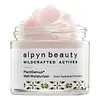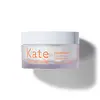What's inside
What's inside
 Key Ingredients
Key Ingredients

 Benefits
Benefits

 Concerns
Concerns

 Ingredients Side-by-side
Ingredients Side-by-side

Water
Skin ConditioningSodium Hyaluronate
HumectantCetyl Alcohol
EmollientCoconut Alkanes
EmollientGlycerin
HumectantPyrus Malus Fruit Extract
Skin ConditioningPotassium Cetyl Phosphate
EmulsifyingAloe Barbadensis Leaf Juice
Skin ConditioningPrunus Armeniaca Kernel Oil
MaskingCapryloyl Glycerin/Sebacic Acid Copolymer
Skin ConditioningCoco-Caprylate/Caprate
EmollientDiheptyl Succinate
EmollientCentella Asiatica Meristem Cell Culture
AntioxidantXanthan Gum
EmulsifyingSorbitan Stearate
EmulsifyingDehydroacetic Acid
PreservativeBenzyl Alcohol
PerfumingSqualane
EmollientTripeptide-29
Skin ConditioningOlea Europaea Fruit Oil
MaskingGlycolic Acid
BufferingMica
Cosmetic ColorantTitanium Dioxide
Cosmetic ColorantPotassium Sorbate
PreservativeButyrospermum Parkii Butter
Skin ConditioningTocopherol
AntioxidantLinoleic Acid
CleansingLavandula Angustifolia Oil
MaskingCitrus Aurantium Dulcis Oil
MaskingCoenochloris Signiensis Extract
Skin ConditioningMaltodextrin
AbsorbentLecithin
EmollientBakuchiol
AntimicrobialHydrolyzed Sodium Hyaluronate
Skin ConditioningEclipta Prostrata Extract
Skin ConditioningMelia Azadirachta Leaf Extract
Skin ConditioningMoringa Oleifera Seed Oil
EmollientCeramide Ng
Skin ConditioningAscorbic Acid
AntioxidantSimmondsia Chinensis Seed Oil
EmollientSalvia Officinalis Leaf Extract
CleansingArnica Montana Flower Extract
MaskingBorago Officinalis Extract
EmollientCalendula Officinalis Flower Extract
MaskingChamomilla Recutita Flower Extract
MaskingWater, Sodium Hyaluronate, Cetyl Alcohol, Coconut Alkanes, Glycerin, Pyrus Malus Fruit Extract, Potassium Cetyl Phosphate, Aloe Barbadensis Leaf Juice, Prunus Armeniaca Kernel Oil, Capryloyl Glycerin/Sebacic Acid Copolymer, Coco-Caprylate/Caprate, Diheptyl Succinate, Centella Asiatica Meristem Cell Culture, Xanthan Gum, Sorbitan Stearate, Dehydroacetic Acid, Benzyl Alcohol, Squalane, Tripeptide-29, Olea Europaea Fruit Oil, Glycolic Acid, Mica, Titanium Dioxide, Potassium Sorbate, Butyrospermum Parkii Butter, Tocopherol, Linoleic Acid, Lavandula Angustifolia Oil, Citrus Aurantium Dulcis Oil, Coenochloris Signiensis Extract, Maltodextrin, Lecithin, Bakuchiol, Hydrolyzed Sodium Hyaluronate, Eclipta Prostrata Extract, Melia Azadirachta Leaf Extract, Moringa Oleifera Seed Oil, Ceramide Ng, Ascorbic Acid, Simmondsia Chinensis Seed Oil, Salvia Officinalis Leaf Extract, Arnica Montana Flower Extract, Borago Officinalis Extract, Calendula Officinalis Flower Extract, Chamomilla Recutita Flower Extract
Water
Skin ConditioningCetyl Ricinoleate
EmollientIsostearyl Palmitate
EmollientDimethicone
EmollientSqualane
EmollientLactic Acid
BufferingGlyceryl Stearate
EmollientPEG-100 Stearate
Propanediol
SolventGlycolic Acid
BufferingMyristyl Alcohol
EmollientCyclopentasiloxane
EmollientSodium Hydroxide
BufferingLactobacillus/Pumpkin Fruit Ferment Filtrate
Skin ConditioningLeuconostoc/Radish Root Ferment Filtrate
AntimicrobialBromelain
Skin ConditioningPapain
Skin ConditioningOpuntia Ficus-Indica Fruit Extract
Skin ConditioningGlycerin
HumectantSaccharomyces Cerevisiae Extract
Skin ConditioningPolysilicone-11
Citrus Aurantium Bergamia Fruit Oil
MaskingAniba Rosaeodora Wood Extract
MaskingCitrus Aurantium Dulcis Peel Oil
MaskingPelargonium Graveolens Flower Oil
MaskingTocopheryl Acetate
AntioxidantPhenoxyethanol
PreservativePolyacrylate Crosspolymer-6
Emulsion StabilisingMyristyl Glucoside
CleansingCyclohexasiloxane
EmollientPEG-40 Stearate
EmulsifyingXanthan Gum
EmulsifyingEthylhexylglycerin
Skin ConditioningDisodium EDTA
Maltodextrin
AbsorbentT-Butyl Alcohol
PerfumingCitronellol
PerfumingBenzyl Benzoate
AntimicrobialCitral
PerfumingLimonene
PerfumingLinalool
PerfumingGeraniol
PerfumingCI 75810
Cosmetic ColorantWater, Cetyl Ricinoleate, Isostearyl Palmitate, Dimethicone, Squalane, Lactic Acid, Glyceryl Stearate, PEG-100 Stearate, Propanediol, Glycolic Acid, Myristyl Alcohol, Cyclopentasiloxane, Sodium Hydroxide, Lactobacillus/Pumpkin Fruit Ferment Filtrate, Leuconostoc/Radish Root Ferment Filtrate, Bromelain, Papain, Opuntia Ficus-Indica Fruit Extract, Glycerin, Saccharomyces Cerevisiae Extract, Polysilicone-11, Citrus Aurantium Bergamia Fruit Oil, Aniba Rosaeodora Wood Extract, Citrus Aurantium Dulcis Peel Oil, Pelargonium Graveolens Flower Oil, Tocopheryl Acetate, Phenoxyethanol, Polyacrylate Crosspolymer-6, Myristyl Glucoside, Cyclohexasiloxane, PEG-40 Stearate, Xanthan Gum, Ethylhexylglycerin, Disodium EDTA, Maltodextrin, T-Butyl Alcohol, Citronellol, Benzyl Benzoate, Citral, Limonene, Linalool, Geraniol, CI 75810
Ingredients Explained
These ingredients are found in both products.
Ingredients higher up in an ingredient list are typically present in a larger amount.
Glycerin is already naturally found in your skin. It helps moisturize and protect your skin.
A study from 2016 found glycerin to be more effective as a humectant than AHAs and hyaluronic acid.
As a humectant, it helps the skin stay hydrated by pulling moisture to your skin. The low molecular weight of glycerin allows it to pull moisture into the deeper layers of your skin.
Hydrated skin improves your skin barrier; Your skin barrier helps protect against irritants and bacteria.
Glycerin has also been found to have antimicrobial and antiviral properties. Due to these properties, glycerin is often used in wound and burn treatments.
In cosmetics, glycerin is usually derived from plants such as soybean or palm. However, it can also be sourced from animals, such as tallow or animal fat.
This ingredient is organic, colorless, odorless, and non-toxic.
Glycerin is the name for this ingredient in American English. British English uses Glycerol/Glycerine.
Learn more about GlycerinGlycolic Acid is arguably the most famous alpha hydroxy acid (AHA) with tons of research backing its benefits.
It is found naturally in sugar cane but the form used in skincare is usually synthetic for purity and stability.
Glycolic acid removes the top layer of dead skin cells to allow newer and fresher ones to emerge.
AHAs work by breaking down the structural “glue” that holds old skin cells in place. When that buildup is gone, your skin can renew itself more efficiently.
Research also shows glycolic acid stimulates collagen production, helping to firm and thicken the skin over time. This is one of its biggest advantages over other AHAs.
Overall, glycolic acid helps with:
Fun fact: Glycolic acid boosts skin hydration by helping it produce molecules that increase hyaluronic acid naturally.
To work best, glycolic acid products should have a pH between 3-4 (that’s where exfoliation is most effective but still gentle on skin).
The pH and concentration of a product are key to its effectiveness:
It is normal to feel a slight stinging sensation when using glycolic acid. This usually fades as your skin adjusts.
Because glycolic acid has the smallest molecular size in the AHA family, it can penetrate deeper, which enhances its effectiveness but also makes it more likely to irritate sensitive skin.
If your skin is very sensitive or prone to rosacea, glycolic acid may be too strong; in that case, try milder options like lactic acid or a PHA instead.
Recent studies suggest glycolic acid might even help protect against UV damage. But don’t skip sunscreen! Freshly exfoliated skin is more sensitive to the sun.
Glycolic acid is a skincare superstar. It smooths, brightens, hydrates, and firms the skin. Unless you’re highly sensitive, it’s well worth adding to your routine.
Read more about some other popular AHA's here:
Learn more about Glycolic AcidMaltodextrin is a polysaccharide. It is derived from starch such as rice, corn, wheat, or potato starch.
In food, Maltodextrin is used to improve the texture and thicken a product. Due to its structure, it can help create a gel texture. As an emulsion stabilizer, it helps keep the ingredients in a product together.
As a polysaccharide, Maltodextrin has moisturizing properties. Polysaccharides are a type of carbohydrate. The top layer of skin uses polysaccharides to retain water, keeping the skin hydrated.
Maltodextrin is water soluble and has a sweet taste.
Learn more about MaltodextrinSqualane is an emollient that helps the skin hold onto moisture. It's an oily liquid that occurs naturally in certain types of fish and plant oils.
Because squalane boosts hydration in the skin, it also comes with plenty of benefits: it is an antioxidant and can help fight free radicals and skin damage. Squalane is also found to have a detoxifying effect when applied.
Squalane comes from squalene, which occurs naturally within the sebum of our skin. It is one of the oils our skin produces to keep itself hydrated. Squalane is the hydrogenated version of squalene and has a longer shelf life.
Research shows that squalane is non-irritating (even at 100% concentration).
In general, it's a fantastic ingredient. It does a great job at hydrating the skin, and it's suitable for those with sensitive skin.
The source of squalane may impact malassezia / fungal acne. This is because olive oil derived squalane can contain impurities such as fatty acids and plant waxes. Sugarcane derived squalane is recommended for anyone with malassezia concerns.
Is squalane vegan?
This depends on the source. Squalane can be derived from both plants and animals. Most squalane used in skincare comes from plants.
Please note: the source of squalane is only known if disclosed by the brand. We recommend reaching out to the brand if you have any questions about their squalane.
Read more about squalene with an "e".
Is squalane an oil?
Squalane is often called an oil, but it’s technically not; it’s a hydrocarbon, meaning it’s only made of carbon and hydrogen, unlike true oils which are triglycerides made of fatty acids and glycerol.
The term “oil-free” isn’t regulated, so companies can define it however they want. Some exclude all oils, while others just avoid mineral oil or comedogenic oils.
While some people avoid oils thinking they cause breakouts, the right kind of oil (or oil-like ingredient like squalane) can actually help balance and hydrate your skin. It’s worth testing out simple oils or squalane to see what works best for your skin.
Learn more about SqualaneWater. It's the most common cosmetic ingredient of all. You'll usually see it at the top of ingredient lists, meaning that it makes up the largest part of the product.
So why is it so popular? Water most often acts as a solvent - this means that it helps dissolve other ingredients into the formulation.
You'll also recognize water as that liquid we all need to stay alive. If you see this, drink a glass of water. Stay hydrated!
Learn more about WaterXanthan gum is used as a stabilizer and thickener within cosmetic products. It helps give products a sticky, thick feeling - preventing them from being too runny.
On the technical side of things, xanthan gum is a polysaccharide - a combination consisting of multiple sugar molecules bonded together.
Xanthan gum is a pretty common and great ingredient. It is a natural, non-toxic, non-irritating ingredient that is also commonly used in food products.
Learn more about Xanthan Gum